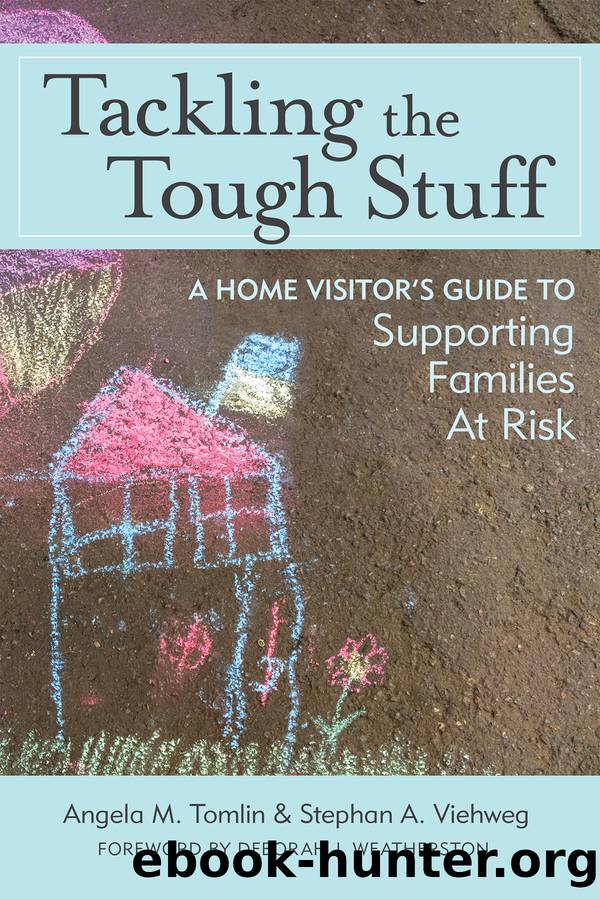Tackling the Tough Stuff by unknow

Author:unknow
Language: eng
Format: epub
Tags: BISAC: FAMILY & RELATIONSHIPS/Life Stages/Infants & Toddlers, FAMILY & RELATIONSHIPS/Children with Special Needs, FAMILY & RELATIONSHIPS/General
Publisher: Brookes Publishing
Published: 2016-02-22T00:00:00+00:00
DEVELOPING PROSOCIAL BEHAVIORS
Young children may need guidance in developing the prosocial behaviors that help them succeed in life. In the following subsections, we discuss the development of the prosocial behaviors of compliance and self-regulation of feelings, as well as of other social and emotional skills.
Developing Compliance
The term compliance is used to describe a child doing what the parent or other caregiver wants, requests, or commands (Landy, 2009). This can include following directions to complete a specific task or instructions to stop doing or not do something. As any parent will attest, convincing a young child to do what the parent wants or getting them to stop doing what they want to do can be challenging. Both understanding what the parent wants and willingness to do it are involved in compliance.
Although most children are able to understand what a parent wants, in most situations, by age 3 years, they may not always perform to their potential ability. In younger children, normal deficits in self-control may contribute to lower compliance. This can confuse parents who may hear their 2-year-old correcting her dolls or telling others âno, noâ and believe this behavior indicates full understanding of discipline. Being able to repeat a command is not the same as fully understanding it or being able to comply. In addition, of course, it is not unusual for the parent and the child to have different ideas about what the child should be doing. So, at times, a child may just not want to comply in given situations, even though they have the skill. An example might be the parent instructing a child to put away toys to get ready for bed. From the childâs perspective, playing is fun or perhaps the tower is not finished. Although the child understands the command and is able to perform it, he or she does not want to because going to bed means missing out on more fun with toys.
Parents and other caregivers generally target the beginning of problems with compliance with commands to age 2 years. Thus, there are terms like âthe terrible twos.â However, compliance problems typically start much earlier. Very high levels of noncompliance are reported between 12 and 24 months (Landy, 2009). Once a child is able to walk, around the end of the first year, compliance becomes very important to parents. This is because as infants becomes toddlers, they are able to have more control over how close or far they are from parents, resulting in games of âcatch meâ and other safety concerns. Children in this age range can run, jump, climb, and explore; therefore, they can also find interesting and often possibly forbidden objects, resulting in the need for parents to monitor them closely. Parents who feel that they are in near continual conflict with their young children are probably right! From this rocky start between 12 and 24 months, most typically developing 3-year-olds will increasingly show skills such as knowing what behaviors adults expect, following rules, demonstrating self-control, and expressing feelings of pride and shame (Forman, 2007).
Download
This site does not store any files on its server. We only index and link to content provided by other sites. Please contact the content providers to delete copyright contents if any and email us, we'll remove relevant links or contents immediately.
Whiskies (Collins Gem) by dominic roskrow(45162)
Spell It Out by David Crystal(36083)
Cecilia; Or, Memoirs of an Heiress — Volume 1 by Fanny Burney(32495)
Cecilia; Or, Memoirs of an Heiress — Volume 2 by Fanny Burney(31909)
Cecilia; Or, Memoirs of an Heiress — Volume 3 by Fanny Burney(31892)
Beautiful Disaster by McGuire Jamie(25283)
Trainspotting by Irvine Welsh(21568)
Chic & Unique Celebration Cakes by Zoe Clark(20007)
The Secret History by Donna Tartt(18945)
How High Can a Kangaroo Hop? by Jackie French(18783)
Twilight of the Idols With the Antichrist and Ecce Homo by Friedrich Nietzsche(18565)
All the Missing Girls by Megan Miranda(15773)
Cat's cradle by Kurt Vonnegut(15256)
Ready Player One by Cline Ernest(14574)
For the Love of Europe by Rick Steves(13558)
Fifty Shades Freed by E L James(13186)
4 3 2 1: A Novel by Paul Auster(12329)
Crooked Kingdom: Book 2 (Six of Crows) by Bardugo Leigh(12256)
Grundlagen Kreatives Schreiben (German Edition) by Helfferich Pia(10422)
